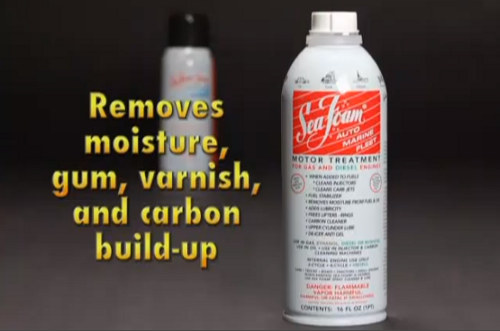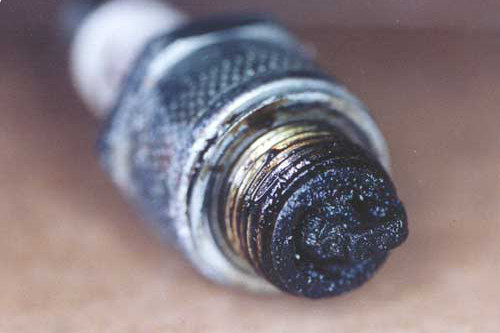Should You Sea Foam Your Tundra? I Wouldn’t
Jason Lancaster | Feb 19, 2013 | Comments 12
A recent thread on TundraSolutions.com about using Sea Foam – a chemical designed to remove carbon deposits from inside your engine – got Tim and I talking. Would we use it on our vehicles? Why or why not?

Should you use Sea Foam on your Tundra? There are a lot of reasons to be cautious.
While I don’t think Sea Foam is bad for vehicles (it isn’t, at least if it’s used correctly), I’d say that it’s a bad investment for most vehicle owners. Here’s why:
1. Like any corrosive additive, improper use of Sea Foam can harm your engine. If you don’t follow directions, don’t be surprised to have problems. Sea Foam is a mixture of naptha and alcohol – two things that your engine can process in small quantities, but in large quantities can kill your motor.
2. The amount of carbon build-up in modern engines is significantly reduced compared to just 20 years ago, let alone 40 years ago. As a result of better design and electronic control, engines benefit from these types of treatments with far less frequency than they used to. I would go so far as to say that many engines have absolutely no need for Sea Foam treatment, especially if they’ve been well maintained.
3. Sea Foam benefits are a bit nebulous. Most people who use this treatment talk about a smoother idle and/or a slightly better “feel” under acceleration. These are good things, but are they really beneficial?
The Sea Foam website doesn’t publish any data that shows Sea Foam will restore lost power or improve fuel economy. As a matter of fact, the Sea Foam website specifically states that it does NOT do either of these things. From Sea Foam’s website:
If your engine is being affected by significant deposit build-up, you will likely see an improvement to like new fuel mileage with continued use of Sea Foam because you will have removed these hindrances to performance. But Sea Foam is NOT promoted to be a “mileage enhancer” product as such.
Please note the use of the words “significant deposit build-up.” Running Sea Foam through an engine with moderate or slight build-up likely won’t deliver benefits (and this matches my experience with these types of additives).

A spark plug with large amounts of carbon build-up. Do your plugs look like this? If so, you’ve got a carbon problem.
While some people may see Sea Foam’s unwillingness to talk about results as “legalese,” the fact is that the benefits to the Sea Foam process aren’t usually obvious. While a smoother idle is nice – and some have reported better fuel economy, more power, etc. – most people who put Sea Foam into their vehicles see no measurable change.
What’s more, improvements in fuel economy and additional power could be a result of replacing the fuel filter, replacing the spark plugs, etc., which are things people often do after completing a Sea Foam treatment.
4. Sea Foam isn’t for amateurs. There are HUNDREDS of documented incidents where people have used Sea Foam and experienced catalytic converter failure, O2 sensor failure, damaged actuators inside the air intake manifold (remember, your Tundra has an ACIS system), and a bunch of other issues. While Sea Foam advocates argue that these problems are all caused by improper use, that will be little comfort if you have a problem.
Put another way, Sea Foam can be tricky. If you don’t take great care when you use it, you could end up with a headache.
5. Toyota does not recommend Sea Foam, or any other treatments like it. Make of it what you will, but no manufacturer recommends this sort of aggressive treatment as part of any regular maintenance cycle.
NOTE: As MPToy07 points out in the comments, there are some situations where Toyota (and other manufacturers) recommend using chemicals like Sea Foam. As a general rule, these vehicles utilize direct injection. See the exchange below (and bonus points for MPToy07 for calling me out!)
Bottom Line
For those of you who don’t know me, and/or for those who are wondering “Why the hell should I care about what this guy says?“, here’s my background info.

Jason Lancaster
I’m the founder of TundraHeadquarters.com. Since 2007, I’ve been writing about trucks, reviewing accessories, talking to all kinds of experts in the auto industry, etc. Before founding TundraHeadquarters, I spent 9 years working at auto dealerships. While I’ve never turned a wrench professionally, I’ve worked on my own cars and helped manage dealership service departments. I also have an engineering degree. I’m well-versed in all things automotive.
Is my opinion on Sea Foam extremely qualified? Admittedly no. There are people who know a lot more about the chemistry behind Sea Foam, people who know a lot more about rebuilding engines and removing carbon build-up, etc. than I do.
However, for what it’s worth, I personally wouldn’t bother with Sea Foam. If I had reason to suspect that my engine had a lot of carbon build-up, I’d find a shop offering the Terraclean decarbonizing system, make sure they knew what the hell they were doing, and then pay the money. It’s more effective and less risky.
Filed Under: Maintenance Tips


I agree with Mr Clean and would never run SF through my Tundra.
Although being an avid off road motorcycle enthusiast with a garage full of gas engine toys I consider sea foam a fantastic product.
One of the bikes I logged thousands of miles across Baja Mexico sat for two years with Pemex still in the tank and carb. The bike wouldn’t start or even run so I drained the tank, added some fresh gas, injected sea foam directly into the carb through the fuel line and let it sit over night. The next day I drained the float bowl, opened the petcock, twisted the throttle a few times, kicked it over 3 times and she started up on the third kick. I was very excited as sea foam saved me from having to rip the carb apart for a cleaning.
LOL – Mr Clean is a nickname that I don’t deserve. He had a lot more muscle.
To your comment, bikes are completely different. The smaller motors make even small amounts of carbon buildup a problem, and unlike fancy vehicle engines that are heavily regulated in terms of efficiency and emissions, bike engines are relatively dirty.
SO, “gunk” is often an issue in dirt bikes, road bikes, harley’s etc., with heavy use.
But modern engines in well-cared for vehicles? Rare (at least that’s my experience).
Thanks for commenting.
Thanks Dez. I am boiling out my under used ’79 KZ650 carbs every 7 or so years, will try sea foam next time.
Sf will definitely clear your jets of any carmelized fuel that is causing clogs. This is a typical problem with older motors or motors that have been sitting for a while.
Great article Jason; very well explained. Many owners aren’t aware of the advances in engine design and fuel quality in recent years that keeps the valves, injectors, and combustion chambers very clean in modern engines; Tundra is no exception.
I would like to clear up one portion of your article a little bit though; Seafoam and other “top engine cleaners” are still a widespread and generally accepted repair by many manufacturers for excessive carbon buildup. Proof of this can be found in a Lexus Service Bulletin L-SB-0029-10, where GM Top Engine Cleaner is effectively used to remove carbon from certain IS250 vehicles. This bulletin has also been recommended to me for use in other Toyota vehicles having similar issues. As long as the proper procedure is followed exactly, the risk of engine component damage is very low.
Seafoam does still have its place in the automotive market, but I agree 100% with you that using it regularly as a maintenance item is unnecessary, and could potentially be dangerous if not performed correctly.
First of all, thanks!
Second, good call on the IS250. Many manufacturers recommend using some sort of carbon build-up removal for direct injection engines, especially older direct injection engines, as these earlier designs weren’t that great at managing temps in the combustion chamber.
I read that newer DI systems (like Ford’s EcoBoost) won’t have any carbon build-up problems, but like all things the proof is in the pudding.
We’re on the same page, and I should have put a note in the article about certain DI engines. I’m fixing it now.
I never used sea foam. I use shell gas which has the additives to clean your engine already. Now sea foam may help me with my new genearator and new pressure washer. Both won’t start and both don’t like the ethanol gas mixture. I can’t believe the govt would force us to use ethanol but these small engines can’t use them at all. I will try the sea foam just to see. What worst can I get. They both won’t start and only 2 years old and barely 12 hours use on pressure washer and only 20 minute use on generator.
Good Luck!
-Tim
Give it a shot Mic! Sea Foam loves motors like that!
i use seafoam gas treatment on my goldwing 6 cylinder engine from time to time no more than 1/4 of 16 ounce can but know of several who put in a whole can every so often with a 6 gallon gas tank no problems as well. they swear by the stuff. I also use it in my lawnmowers, rototillers, and snow blowers since it does help remove moisture/water along with the ill effects of ethanol in gas, but just don’t overdue it a few small squirts will be plenty in those seldom used, small engines.
Definitely, what a splendid blog and illuminating posts, I will bookmark your website.Have an awsome day!
You should try sea foam in your Mac, iPad, pc, or even your smart phone! It cleans all the junk out! 🙂